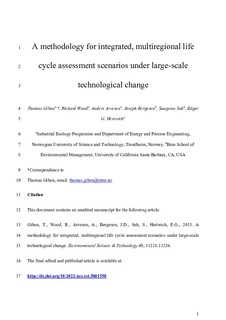| dc.contributor.author | Gibon, Thomas | |
| dc.contributor.author | Wood, Richard | |
| dc.contributor.author | Arvesen, Anders | |
| dc.contributor.author | Bergesen, Joseph | |
| dc.contributor.author | Suh, Sangwon | |
| dc.contributor.author | Hertwich, Edgar G. | |
| dc.date.accessioned | 2017-11-08T14:37:43Z | |
| dc.date.available | 2017-11-08T14:37:43Z | |
| dc.date.created | 2015-09-05T18:14:03Z | |
| dc.date.issued | 2015 | |
| dc.identifier.citation | Environmental Science and Technology. 2015, 49 (18), 11218-11226. | nb_NO |
| dc.identifier.issn | 0013-936X | |
| dc.identifier.uri | http://hdl.handle.net/11250/2465017 | |
| dc.description.abstract | Climate change mitigation demands large-scale technological change on a global level and, if successfully implemented, will significantly affect how products and services are produced and consumed. In order to anticipate the life cycle environmental impacts of products under climate mitigation scenarios, we present the modeling framework of an integrated hybrid life cycle assessment model covering nine world regions. Life cycle assessment databases and multiregional input–output tables are adapted using forecasted changes in technology and resources up to 2050 under a 2 °C scenario. We call the result of this modeling “technology hybridized environmental-economic model with integrated scenarios” (THEMIS). As a case study, we apply THEMIS in an integrated environmental assessment of concentrating solar power. Life-cycle greenhouse gas emissions for this plant range from 33 to 95 g CO2 eq./kWh across different world regions in 2010, falling to 30–87 g CO2 eq./kWh in 2050. Using regional life cycle data yields insightful results. More generally, these results also highlight the need for systematic life cycle frameworks that capture the actual consequences and feedback effects of large-scale policies in the long term. | nb_NO |
| dc.language.iso | eng | nb_NO |
| dc.publisher | American Chemical Society | nb_NO |
| dc.title | A Methodology for Integrated, Multiregional Life Cycle Assessment Scenarios under Large-Scale Technological Change | nb_NO |
| dc.type | Journal article | nb_NO |
| dc.type | Peer reviewed | nb_NO |
| dc.description.version | acceptedVersion | nb_NO |
| dc.source.pagenumber | 11218-11226 | nb_NO |
| dc.source.volume | 49 | nb_NO |
| dc.source.journal | Environmental Science and Technology | nb_NO |
| dc.source.issue | 18 | nb_NO |
| dc.identifier.doi | 10.1021/acs.est.5b01558 | |
| dc.identifier.cristin | 1262176 | |
| dc.relation.project | Norges forskningsråd: 209697 | nb_NO |
| dc.relation.project | Norges forskningsråd: 206998 | nb_NO |
| dc.description.localcode | © American Chemical Society 2015. This is the authors accepted and refereed manuscript to the article. | nb_NO |
| cristin.unitcode | 194,64,25,0 | |
| cristin.unitname | Institutt for energi- og prosessteknikk | |
| cristin.ispublished | true | |
| cristin.fulltext | postprint | |
| cristin.qualitycode | 2 | |
